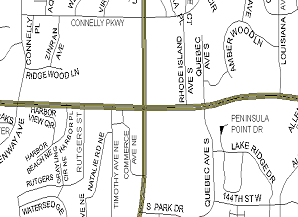MSDI Data: Transportation
 This committee is no longer active. This webpage
provides a record of its activities.
This committee is no longer active. This webpage
provides a record of its activities.
Transportation framework data includes six components: roads, trails, railroads, waterways, airports/ports, and bridges/tunnels. Of these, roads are the most widely used to support GIS and have the highest priority. As critical transportation infrastructure, often roads serve as a base layer or as the primary reference for other map features. Depending upon scale, a variety of road types may be displayed, from interstates to city streets. Road data are challenging to maintain, especially in rapidly growing areas, and public and private organizations may both be involved in monitoring changes. Data producers strive to maintain positionally accurate centerlines and attributes, especially road names and address ranges, but completeness of the data often is inversely proportional to the rate of growth in a given area.
The strategic plan for addressing this state data need was being developed by a transportation data workgroup with assistance from the Strategic Plan Committee of the Governor's Council on Geographic Information.
DATA USES
Tied inextricably to the economy and land use, transportation information is critical to private and public enterprise. Typical uses include: enhanced-911 dispatch and routing, school bus routing, commercial routing and delivery, pavement inventory and planning, land records integration, bikeways mapping, infrastructure planning and management, transit planning and routing, and network analysis.
Many transit and transportation departments use geographic street databases as the foundation for data collection, data integration, and analysis within GIS applications. Road characteristics, such as speed limit, pavement type, and activities, such bus and snowplow routes, can be linked to features directly or through a linear referencing system. Accurate address ranges enable automated geocoding of activities and events. For many organizations, the primary use of road datasets is as a reference layer for maps.
DATA STATUS
Several organizations in Minnesota maintain road datasets for a variety of business needs. Nationwide databases are available from the Census Bureau and USGS, but are of limited use due to their coarse resolution. User needs are more likely to be met by other databases:
- Mn/DOT “Basemap” Data. This dataset is updated continuously by Mn/DOT’s Geographic Information and Mapping Unit, using information obtained internally and from local government units. Basemap data are available to external users, many of whom agree that it is the “best available” source for statewide transportation base data, particularly in rural areas. Road information is distributed as county shapefiles, with built-in linear referencing capabilities. For more information see: www.dot.state.mn.us/tda/basemap/metadata/Roads.htm. Mn/DOT is also developing a Location Data Manager (LDM) to serve as a standard road-referencing system, which will foster data integration and sharing.
- The Lawrence Group (TLG) Street Centerline and Address Ranges. This proprietary dataset covers 23 counties in two states, including the Twin Cities metropolitan area. Endorsed by MetroGIS for address matching, it is issued quarterly with updated centerlines and attributes. Mn/DOT and the Metropolitan Council have funded a licensing agreement making this dataset available to all state and local government agencies and colleges and universities in the state.
- Local large-scale Data Sources. County engineers and municipal officials in many areas compile high-accuracy, large-scale data, often to support parcel mapping or infrastructure management. Frequently developed in automated drafting systems, these data can be imported into GIS applications and integrated with geospatial data. They will continue to be created and maintained for locally specific large-scale applications, and they are an important potential source of updates in any transportation data sharing efforts.
Pre-Assembled Data. Some rural areas support GIS applications with vendor-specific packages of street networks, which are often spatially imprecise and incomplete. They remedy this with custom improvements generated from local knowledge; this is another potential source of updates in any transportation data sharing efforts.
PLAN STATUS
Work on the MSDI Data Plan for roads was not completed.
COSTS AND FINANCING
No solid information on costs and financing is currently available. Mn/DOT’s LDM project will likely meet the needs of many, but not all users. Integrating TLG data and local datasets with the LDM may pose a significant increase in maintenance costs for those data producers. MetroGIS is working to estimate these cost for the Twin Cities area.
KEY ISSUES
- Road layers must be continually updated to remain useful. Data producers maintain these updates to meet their internal business needs, which do not always translate directly to the needs of the greater community of users.
- Data development and maintenance responsibilities are spread across disparate organizations with strikingly different accuracy and content standards. A collaborative strategy needs to be defined and implemented in order to aggregate data critical to the MSDI Roads Element.
- While Mn/DOT is attempting to establish a “common denominator” for referencing, integrating, and sharing road data, common definitions and best practices must be established by producers and users in order to maximize the effectiveness of this system.
- Significant investments have been made in the TLG dataset and similar public-private ventures, but licensing restrictions may inhibit complete integration with other datasets.
RESOURCES
- The Minnesota Transportation Framework. Report prepared by Westcott and Associates in 2000 that provides a comprehensive assessment of Minnesota's management of transportation data. Produced with funding from the Federal Geographic Data Committee as an NSDI Framework Data study.

